Ryan Stuart takes a look back to appreciate the evolution of Revelstoke Mountain Resort.
Some people run their winters by the 20-cm rule. Slackers might use 15 cm as their threshold for coming in late to work. Me? After one run at Revelstoke Mountain Resort (RMR), I’m thinking eight is the magic number.
With patrol only recording a paltry snowman’s worth of overnight snowfall, I take my time getting out of my base-side hotel room. I knock off a couple hours of work, make some calls, have a second cup of coffee… Around 10 I stroll out of the Sutton Place Hotel and walk right onto the gondola. Things don’t look promising. If anything, it looks as though patrol overestimated; it’s maybe five cm of dust on a rock-hard crust. And all I have are my powder skis.
Twenty minutes later I’m at the top of the mountain following a couple of other skiers on the climbing traverse toward North Bowl thinking I should have rolled out of bed earlier. With each step, the snow on the sides of the track keeps getting deeper and the crust underneath keeps getting softer. The North Bowl is barely tracked and there’s only a handful of people in sight. I traverse all the way around to Greely Bowl and find even fewer tracks. The snow keeps getting deeper the farther I go. I buzz past a small group and drop right in, swooping over the rolls at the top of the bowl, fresh snow blowing up to my waist on the harder turns, at least to my knees the rest of the time.
The conditions remind me of the last time I skied here. That was a 20-cm day and nine years ago. The place was pretty quiet then, too, but the resort was only a year old. The 2017-18 season was RMR’s 10th anniversary. After a nine-year absence I’m back in Revelstoke to see how things have changed and how much they remain the same.
**********************************************************************************
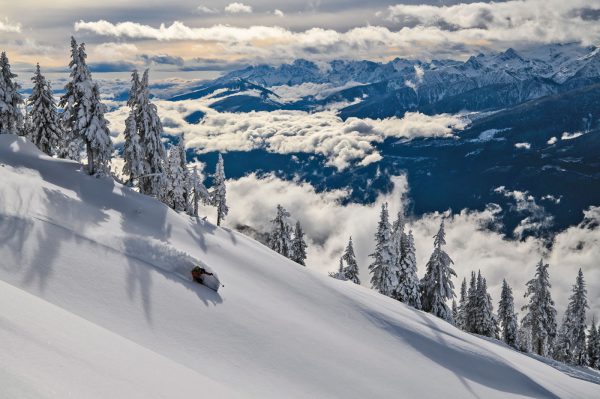
The first time I skied Revelstoke was in 1998. What would become RMR was a community ski hill with a snowcat-skiing operation plying the upper slopes of Mt. Mackenzie. Back then Revelstoke was just a stop on the way to somewhere better: snowcat, heli or backcountry operations. Even the town left little impression—except that there was a ton of snow.
I returned in April 2007 to report on the soon-to-be ski resort. A photographer and I hooked up with a local who snowmobiled us to the top of the ski resort. We ski toured around the upper mountain, skied steep lines and then meandered back down to the bottom, dodging a crew plowing the access road, preparing for lift installation. I remember the ski down seemed to take forever; as well, the setting sun lit up the Columbia River far below.
In 2007 the town of Revelstoke was quaint and quiet, if a little rough around the edges. Any vehicle but a dirty pickup truck seemed out of place where most locals worked in logging or for the railway. There were a couple of great eateries and outdoor shops however. And a growing contingent of mountain guides and backcountry ski bums gave the town an eclectic flair. They lived here to be in the mountains, backcountry skiing, climbing and hiking. Most seemed ambivalent about the coming ski resort.
When RMR opened in December 2007, it was hailed as the biggest resort opening in North America in 20 years. Revy’s new gondola and high-speed quad climbed 1,510m up the mountain. The next year the gondola was extended down to the present base area and a second quad chair was added high on the mountain. The 200m addition instantly gave RMR an impressive cred: the longest vertical drop in North America.
I sampled it that spring, arriving during a non-stop March storm cycle, which dropped 15 to 20 cm of fresh snow every day. Where the resort’s base village now sits there was a construction site of a half-finished hotel, restaurants and base lodge. I loaded right onto the gondola and rode up with a bunch of young skiers and snowboarders who’d come to town because of all the hype. I followed them into North Bowl and into the trees, getting lost in the expanse. The skiing was, as we said back then, “epic.” I remember my legs burning while skiing Kill the Banker top to bottom at the end of the day.
Down in town, things hadn’t changed much on the surface. Little in the way of new development had begun, but locals were already worried about rising property prices. As well, a few new businesses were open on the main street, catering to the slowly growing number of tourists coming to town.
****************************************************************************************************
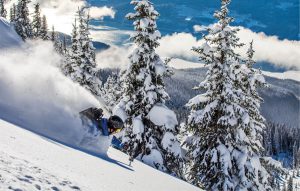
The first thing I notice when I return in March 2018 is that I don’t recognize anything. For one, I fly into the tiny airport from Vancouver on a new direct charter service. On the tarmac snowbanks dwarf the cramped plane. New and renovated hotels crowd the Trans-Canada Highway. Fancy coffee shops and restaurants are all over the downtown. SUVs, Audis and Volvos outnumber pickups. The Sutton Place Hotel, at the resort’s base, includes three towering buildings. Soft music plays in the lobby, valets and porters bustle around helping guests. It feels cosmopolitan. On the lifts I keep running into Americans.
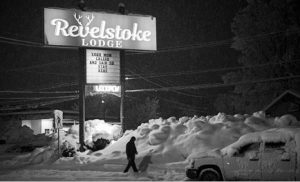
“I think the resort has had an impact on Western Canada skiing and North American skiing,” says Peter Nielson, VP of operations for the resort. “Revelstoke has always had ski history, but mostly backcountry, cat- and helicopter-skiing. The resort made the legendary terrain, snow quality and snow quantity accessible to the masses. It’s become an aspirational destination for passionate skiers all over the world.”
The continent’s longest vertical, consistent snowfall and as a new stop for a couple of Freeride World Tour competitions all helped put RMR on the map. But it might be the resort’s inclusion in both Mountain Collective and Ikon Pass, multi-resort ski passes, that really propelled it to all-star status; most of the out-of-town skiers I meet are here because of that—and “the skiing’s crap in the U.S.”
Locally, the resort has had a significant impact on the local economy, says Nielson. The traffic it draws has added diversity and vibrancy to the town. In 2013, there was concern among some residents that RMR was a drain on civic resources. In response, the resort compiled an economic impact study. In the seven years after RMR opened, the number of business licences issued by the city of Revelstoke increased 30 per cent, and the city budget doubled to nearly $20 million. Resort operations generated $7 million a year in expenditures in the local economy, paid $1.4 million in property taxes and employed more than 500 people with a combination of seasonal and year-round work.
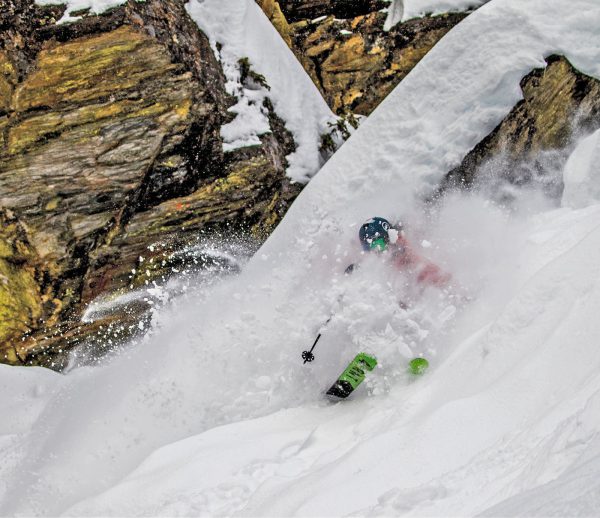
Another local complaint was the slow pace of expansion. Like most ski resort proposals, plans for RMR were dreamy and often unrealistic. The master plan called for build-out within 15 years with a total area of more than 4,047 hectares. A decade in and it’s at 1,227. “Ten years is not a long period in terms of resort development,” reminds Nielson on the subject of what’s been accomplished thus far. Plus, timing was tough. RMR started work on the resort base in 2008. “We kept building through the worst of financial crisis.”
A common refrain to describe the new Revelstoke heard during all the hype 10 years ago was “The next Whistler.” Reality of course only set in when dreamers were reminded that Whistler and its heaps of visitors from around the world wouldn’t exist if it weren’t for the nearly three million people of the Lower Mainland who are within a couple hours’ drive and are often forgotten in the resort’s success. Revelstoke’s significantly longer drive than Whistler’s is both a benefit and a development determent.
At Ski Canada’s press time in September, RMR announced a corporate coup with the appointment of new president, David Brownlie, former CEO of Whistler Blackcomb. Brownlie’s personal departure to Revy from the country’s grande dame of ski resorts after 29 years was interesting all on its own but many are more than excited to see what his expertise in ski area management, real estate development and overall vision will be for RMR.
RMR has focused on summer infrastructure and operations over the last few years, a trend that will continue with a planned golf course and alpine mountain bike trails. For winter, the resort’s first new chair in a decade is under construction. It will link the gondola with the Ripper Chair. It’s mostly blue and green terrain, a hole in the terrain mix of the upper mountain, but it will also make it easier to lap the Ripper area. It’s part of a plan to develop the area around the top of the gondola into an upper-mountain base, including the future home of the snow school.
“No matter what we do we want to maintain a very high-level experience for our guests,” says Nielson. “We think we’re the best in the world. And we want everything we do to reflect that.”
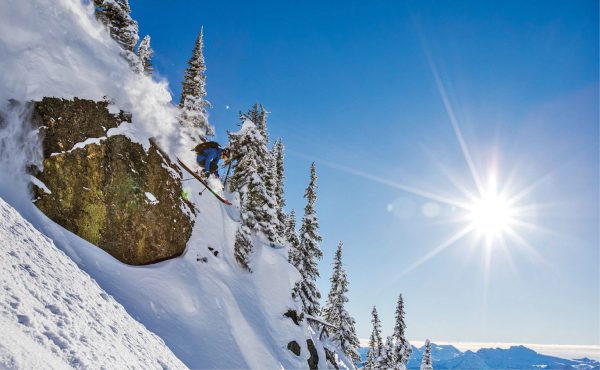
I can’t argue as I take my fourth lap of the North Bowl, still in knee-deep, barely tracked-up snow. It’s mid-afternoon and I’m still almost alone. I haven’t waited in a lift line yet. Friends tell me the resort is usually busy on a powder day, so it feels especially lucky. Apparently, eight cm in mid-March of a deep season doesn’t get the locals excited.
I hike to the top of Mt. Mackenzie for one of my last runs. From the sub-peak above the resort, I spin 360 and take in the endless mountains and terrain stretching for miles to the south and east. There’s so much potential for the resort to get bigger and better.
“In 10 years the resort will look a lot different,” says Nielson. “But the core of the magic will remain around Mt. Mackenzie. It’s a special place year round. It’s the core reason people visit.”
With that thought in mind, I turn back to the run below, a steep line leading into North Bowl. Suddenly a cloud sweeps up from below, obscuring everything around me, except the untracked snow below my tips. I drop off the top down a ridge, the magic of RMR revealing itself with every jump into the abyss.



